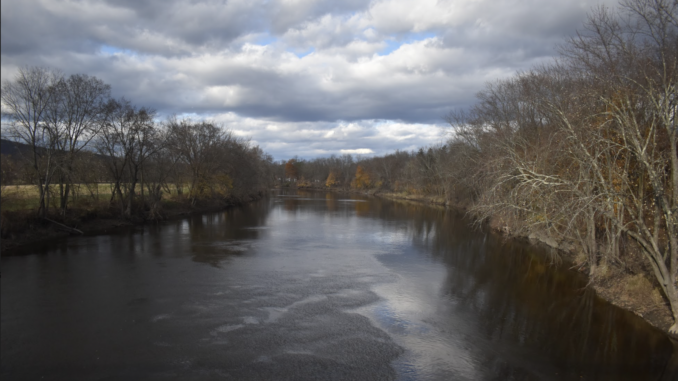
On Oct. 26, another nor’easter barrelled its way through the New Paltz area, causing the Wallkill River to overflow for the second time this fall.
The section of Rt. 299 located west of the Carmine Liberta Bridge was shut down for all of Tuesday, making the trip from town to the Shawangunk Ridge virtually impossible. In a town that is already overwhelmed by traffic, this blockage made rush hour particularly arduous, with backups happening for miles outside of town in either direction.
With the nor’easter bringing in about five inches of rain, the flooding was able to span the width of Rt. 99, joining together the two separate sides of the river.
Though it is natural for the river to flood, it has been happening more frequently and leaving a more destructive trail behind it. The Wallkill View Farm Market, which sits right next to the river, has had to surrender a good portion of their annual crop output in the past two decades to the increased amount of flooding.
“We’ve owned the farm since 1960, and it was almost 40 years before we saw a flood during the season,” says Sande Ferrante, co-owner of Wallkill View. The flood season this year has cost their farm all of its fall crops, including pumpkins, sweet corn and winter squashes.
River flooding is supposed to naturally re-fertilize the surrounding land by depositing minerals, silt and sand into the soil. However, if it happens at the wrong time during the season, it causes ground-dwelling crops to rot.
“All the farmers have noticed that the seasons are warmer, wetter and that brings a lot more molds and mildews,” says Christopher Mercier, owner of Mercier Farms. “There’s a time frame during the year at which molds and mildews come in and that time frame is steadily increasing year after year.”
Not only does the flooding affect farmers, but it has also caused a lot of infrastructural damage for residents in the area. According to floodfactor.com, “there are 60 properties in Wallkill that have greater than a 26% chance of being severely affected by flooding over the next 30 years. This represents 7% of all properties in the city… Flooding is likely to impact day to day life within the community.”
In 1967, Orange County created the Soil and Water Conservation District in order to combat the effects of climate change and provide conservation assistance to farmers. On Thursday, Sept. 30, State Senator Jen Metzger was able to secure a $400,000 state grant for the Wallkill Floodplain Bench Project, which was designed by the interest group in 2013 to prevent future disastrous flooding.
The grant money will allow three acres of soil to be removed along a just-shy-of-a-mile section of land beside the Wallkill, which will create an artificial floodplain for the effected areas. However, in order to fully contain the flooding problem, between $8 and $10 million in state funding is needed to finish the flood mitigation project, which covers an area from Wallkill to the New Jersey border.
With human-driven climate change affecting the weather patterns, making storms more severe and devastating, there is a worry amongst farmers that crop loss is going to increase, which will deeply affect both local and national economies. Agriculture contributes more than $300 billion to the economy each year, but millions are lost alongside the crops due to natural disasters. This has made the floodplain project all the more prominent.
According to the United States Environmental Protection Agency (EPA), “projected increases in temperatures, changes in precipitation patterns, changes in extreme weather events, and reductions in water availability may all result in reduced agricultural productivity.”
“With the amount of rainfall that came down this year, there’s definitely a big impact on crops, not just here but all over the Northeast,” says Mercier. “We just had a very overcast, wet rainy season this year. The ones that felt that the most were the vegetable growers.”
On top of the multiple, costly storms that have swept through the area over the past few years, the COVID-19 pandemic has added extra urgency to the projects completion. Orange County Soil and Water Conservation District Chairman John Wright said, “losing crops is even more unacceptable now because more people are relying on local food.”
Local farmers are hopeful that this project, which is said to be finalized in the next three months, will drastically decrease crop loss and minimize flood damage.
